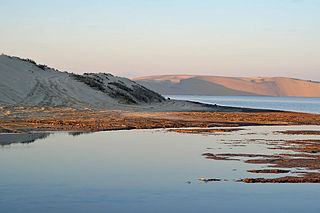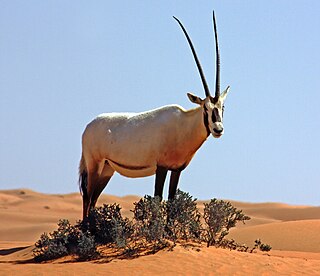This article includes a list of references, related reading or external links, but its sources remain unclear because it lacks inline citations .(May 2018) |
This is a list of protected areas of Saudi Arabia:
This article includes a list of references, related reading or external links, but its sources remain unclear because it lacks inline citations .(May 2018) |
This is a list of protected areas of Saudi Arabia:
There are 15 designated protected areas in Saudi Arabia which are managed by the Saudi Wildlife Authority. [1]

Qatar is a peninsula in the east of Arabia, bordering the Persian Gulf and Saudi Arabia, in a strategic location near major petroleum deposits. The state of Qatar occupies 11,437 km2 (4,416 sq mi) on a peninsula that extends approximately to 160 km (99 mi) north into the Persian Gulf from the Arabian Peninsula.

The Kingdom of Saudi Arabia is a country situated in Southwest Asia, the largest country of Arabia, by the Arabian Peninsula, bordering the Persian Gulf and the Red Sea, north of Yemen. Its extensive coastlines on the Persian Gulf and Red Sea provide great leverage on shipping through the Persian Gulf and the Suez Canal. The kingdom occupies 80% of the Arabian Peninsula. Most of the country's boundaries with the United Arab Emirates (UAE), Oman, and the Republic of Yemen are undefined, so the exact size of the country remains unknown. The Saudi government estimate is at 2,217,949 square kilometres, while other reputable estimates vary between 2,149,690 and 2,240,000 sq. kilometres. Less than 7% of the total area is suitable for cultivation, and in the early 1960s, population distribution varied greatly among the towns of the eastern and western coastal areas, the densely populated interior oases, and the vast, almost empty deserts.

The United Arab Emirates is situated in the Middle East and southwest Asia, bordering the Gulf of Oman and the Persian Gulf, between Oman and Saudi Arabia; it is at a strategic location along the northern approaches to the Strait of Hormuz, a vital transit point for world crude oil. The UAE lies between 22°50′ and 26° north latitude and between 51° and 56°25′ east longitude. It shares a 19 km (12 mi) border with Qatar on the northwest, a 530 km (330 mi) border with Saudi Arabia on the west, south, and southeast, and a 450 km (280 mi) border with Oman on the southeast and northeast.

The Arabian Desert is a vast desert wilderness in Western Asia. It stretches from Yemen to the Persian Gulf and Oman to Jordan and Iraq. It occupies most of the Arabian Peninsula, with an area of 2,330,000 square kilometers (900,000 sq mi). It is the fifth largest desert in the world, and the largest in Asia. At its center is Ar-Rub'al-Khali, one of the largest continuous bodies of sand in the world.

Ras Mohammad is a national park in Egypt at the southern extreme of the Sinai Peninsula, overlooking the Gulf of Suez on the west and the Gulf of Aqaba to the east.

The Arabian leopard is a leopard subspecies native to the Arabian Peninsula. It has been listed as Critically Endangered on the IUCN Red List since 1996 as fewer than 200 wild individuals were estimated to be alive in 2006. The population is severely fragmented. Subpopulations are isolated and not larger than 50 mature individuals. The population is thought to decline continuously.

Ras Al Khor Wildlife Sanctuary is a wetland reserve in Dubai, renowned for attracting large numbers of migratory birds. It is also home to a large population of crustaceans, small mammals, and fish.
Transport in the Arab League describes the land, air, and water transport methods and infrastructure of the countries in the Arab world. Transport infrastructure in the states of the Arab League has been growing, albeit slowly.

The Arabian Peninsula coastal fog desert, also known as the Southwestern Arabian coastal xeric scrub, is desert ecoregion on the southern coasts of the Arabian Peninsula, which experiences thick fogs where visibility may be reduced to 10 metres (33 ft). It is classed as an Afrotropical fog desert

The Arabian oryx, also called the white oryx, was extinct in the wild as of 1972, but was reintroduced to the wild starting in 1982. Initial reintroduction was primarily from two herds: the "World Herd" originally started at the Phoenix Zoo in 1963 from only nine oryx and the Saudi Arabian herd started in 1986 from private collections and some "World Herd" stock by the Saudi National Wildlife Research Center (NWRC). As of 2009 there have been reintroductions in Oman, Saudi Arabia, Israel, the United Arab Emirates, and Jordan, and as of 2013 the IUCN Red List classifies the species as vulnerable.

Protected areas of Qatar include:

Highway 65 is a major north-south controlled-access highway in central Saudi Arabia, spanning 1,427 km. Popularly known as the Riyadh–Qassim Expressway, Highway 65 connects Howtat Bani Tamim to Qurayyat and further to the Al Hadithah border with Jordan, while providing connections to or passing through Riyadh, Majma'ah, al-Ghat, Zulfi, Buraidah, 'Unaizah, ar-Rass, Ha'il, Daumat al-Jandal, Sakakah and other smaller villages and towns. It also provides access to the Naisiyah Wildlife Reserve, Khanafah Wildlife Sanctuary, Tubaiq Natural Reserve, and the Harrat al-Harrah Conservation.
The Wadi Turabah Nature Reserve is a protected area in the Makkah Region of southwestern Saudi Arabia. It is situated about 150 km (93 mi) south-east of Ta'if and 80 km (50 mi) north of al Bahah, sandwiched between the road between Taif and al Bahah and the road running along the escarpment between Banu Sa'ad and al Bahah. It adjoins the Jabal Ibrahim/Wadi Buwwah Protected Area, Jabal Ibrahim being a granite mountain rising about 1,000 m (3,300 ft) above the surrounding rocky hills. Wadi Turabah and Jabal Ibrahim have a total area of around 42,000 hectares and the elevation rises from 1,600 m (5,249 ft) to 2,604 m (8,543 ft) at the summit of Jabal Ibrahim.

The wildlife of the United Arab Emirates is the flora and fauna of the country on the eastern side of the Arabian Peninsula and the southern end of the Persian Gulf. The country offers a variety of habitats for wildlife including the coast, offshore islands, mangrove areas, mudflats, salt pans, sand and gravel plains, sand dunes, mountain slopes, wadis and rocky summits. Because the terrain is so varied, it supports a greater number of species of plants and animals than might have been expected in this relatively small country.

The wildlife of Oman is the flora and fauna of this country in the southeastern corner of the Arabian Peninsula, with coasts on the Gulf of Oman and the Arabian Sea. The climate is hot and dry, apart from the southeastern coast, and the country offers a variety of habitats for wildlife including mountains, valleys, deserts, coastal plains and sea coasts.
{{cite web}}: CS1 maint: url-status (link)